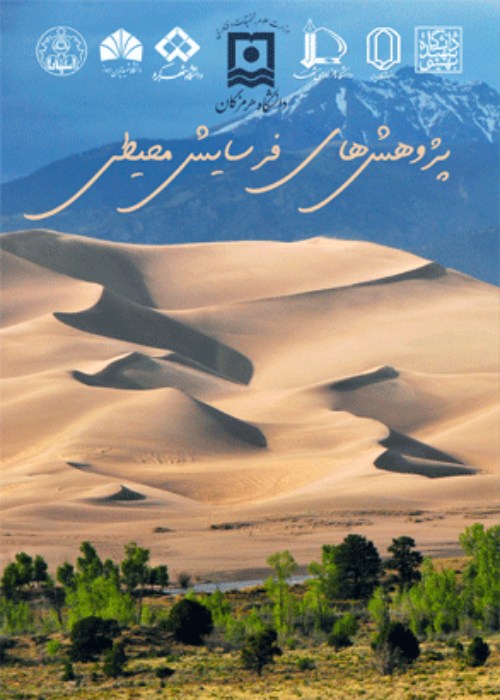Fluctuation Trend Estimation of Water Erosion Zones based on the Time Series of Remote Sensing Images (Case Study: Neor Lake)
The change and evolution of land and water erosion zones through time shows the stability of natural lake ecosystems. Therefore, monitoring the fluctuations of the lake boundary through the preparation of remote sensing data through time, with high spatial and temporal resolution, can reveal the effects of natural hazards, including drought. Compared to other methods, the remote sensing methods due to their ability to easily and cheaply access data, their high accuracy and comprehensiveness, wideness of satellite images and their spectral diversity are considered an effective tool in water resource management and lakes monitoring. Therefore, the importance of monitoring the changes in water-land erosion areas of Lake Neor can provide a suitable platform for making efficient management decisions and prioritizing executive programs to deal with the water shortage crisis. This research has been conducted with the aim of evaluating the changes in water and land erosion areas of lake Neor (as the largest fresh water lake in Ardabil province and one of the most important tourist attractions of this province) in relation to climatic factors during a period of 32 years. This issue has been less discussed in the studies conducted in the region.
Most of the data of this research are time series of Landsat 5 and 8 images during the period of 1988-2020, which were obtained from the website of the US Geological Survey. The map of the studied basin was extracted using ASTER DEM and ARC HYDRO tool. Atmospheric and geometric corrections on the images were applied in ENVI 5.3 software. Water areas were extracted using AWEI, NDWI and NDVI indexes. ARC GIS 10.2 software was used to get the final outputs of the maps. The 32-year climate statistics of the synoptic station of Ardabil city were obtained from the Meteorological Organization of the country in order to investigate the causes of changes in water erosion zones.
The application of three different water indicators on the images indicated that the water area of the lake has decreased from 1988 to 2020 . The largest water area obtained from the AWEISH index in 1992 is 4.1 square kilometers and the smallest lake area in 2019 is 2.2 square kilometers and 2005 with 4.08 square kilometers. The lowest area of the lake according to this index is related to the year 2019 with an area of 2.28 square kilometers and in 1991 with an area equal to 2.26 square kilometers. These numbers have been repeated in other indices with a slight difference. This great fluctuation of the water level of the lake during three decades can have several reasons. In this study, rainfall changes during the studied years have been considered as the main cause. The comparison of the fluctuations of rainfall with changes in the lake level shows the water of the lake has prograded a lot towards the land in the rainy years (1992 and 2005). Also, the performances of three water indexes (general accuracy and Kappa coefficient) were evaluated in the form of Support Vector Machine (SVM) algorithm and the Minimum Distance method. The overall accuracy and Kappa coefficient in all three indicators is higher than 0.92 which indicates the used methods in the extraction of water have high compliance with the land use.
In this research, the surface dynamic changes of Lake Neor in relation to climate fluctuations (precipitation) during the period of 1988-2020 were studied using multi-temporal data. In order to detect the temporal-spatial changes of the lake water level, three different indices of quantitative water extraction (AWEISH, NDVI and NDWI) were used. The performance of each of them (general accuracy and Kappa coefficient) was evaluated in the form of Support Vector Machine (SVM) algorithm and the Minimum Distance method. It was found that the AWEISH index had the lowest error compared to other indices used in the detection of water areas. The results of monitoring three decades of changes in the area revealed that the annual average of the water area of the lake has experienced a decreasing trend. This downward trend has become more intense during the last years of this period due to climate changes and occurrence of recent droughts. In order to optimally manage this lake, considering its environmental importance and tourist attractions, the boundaries of the lake's bed and privacy should be determined by the relevant organizations such as Department Of Environment, Water Resources Management Company and remote sensing researchers. Another suggestion in this regard is to use these indicators in places with diverse geomorphological, climatic and environmental conditions simultaneously to be able to have a better assessment of their accuracy in detecting water areas.
- حق عضویت دریافتی صرف حمایت از نشریات عضو و نگهداری، تکمیل و توسعه مگیران میشود.
- پرداخت حق اشتراک و دانلود مقالات اجازه بازنشر آن در سایر رسانههای چاپی و دیجیتال را به کاربر نمیدهد.



